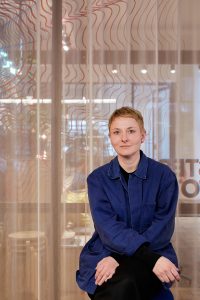Laura Kummer – Hybrid project management
Joined Kinzo in 2012

Hey Laura, you’re back at Kinzo after 12 years – welcome back! Can you tell us a bit about how it all started?
It’s been a decade, over half of Kinzo’s existence. What has changed since then?
Coffee’s always important! Has anything remained the same?
Fast forward to today, you’re now part of Kinzo’s growing Munich team. How has it been, what are you working on these days?
Our projects at the moment are mostly mid-sized and down-to-earth, as well as directly with Munich-based companies. My position is project manager, but I also support in all kinds of issues – helping the site to grow, become better known and develop.
My first impression was that Kinzo Munich is located in the most suitable corner of Munich for Kinzo and that the industry partners seem to be happy about the additional location – simply because Kinzo has made a name for itself nationwide. But it has also been quite a challenge to live the Kinzo DNA without the founders and their history.
Makes sense, most people still associate Kinzo with Berlin – how is the Munich office influenced by that?
Between your engagements at Kinzo, you spent a significant period working at Vitra. Are there any critical learnings you’ve taken from your experiences through the years that you bring to practice today?
And moving forward into this new chapter at Kinzo?
This approach and attitude to projects is very close to that of Kinzo. In this respect, I think I can contribute quite a lot. Especially in the consulting phase. Larger companies have a different corporate culture and organization per se compared to architecture practices. Insights into such can certainly also be interesting to transfer and compare to smaller organizations and teams.
My tasks and experiences recently have also gone beyond pure project business as a team leader. Working in a team for strategic tasks, much of our time has also been about how to market planning services. All these approaches that have shaped me, together with Kinzo‘s own approach, certainly complement and enrich each other well.